In a previous post, we introduced the intelligence gathering discipline of SIGINT, ELINT, FISINT, and COMINT. In this post, we briefly discuss the basics of ISR.
ISR stands for “intelligence, surveillance and reconnaissance.”
Intelligence is a broad term that refers to information gathering. Surveillance refers to closely observing a target itself, while reconnaissance mostly refers to a preliminary survey of an area to gain information. The key distinction between surveillance and reconnaissance lies within the duration and/or goal of the mission. While the goal of surveillance is to actively watch the target over an extended period of time, the goal of reconnaissance missions is usually to retrieve specific information as quickly as possible.

By observing patterns in behavior and tracking movements, experts collect as much information as they can about the opposition.
Being able to predict the enemy’s next move is crucial. Consequently, using the best-suited antenna for an ISR function is also critical. Some ISR antennas are used specifically to intercept communications, including plans and strategies. Other ISR antennas are used to quickly deliver information to relevant parties (for example, battlefield commanders) without detection.
ISR antennas come in a variety of forms. JEM Engineering’s ISR product lines range from card antennas, flat panel antennas for indoor/outdoor use, spiral antennas for larger bandwidths, bicones and omnidirectional antennas, multiband arrays, blade antennas, and more.

The added ‘T’ and ‘A’ in ISTAR stand for “target acquisition.”
While some may use the terms ISR and ISTAR interchangeably, the term ISTAR adds distinction to target acquisition as an activity independent of reconnaissance. Target acquisition is the detection and identification of the location of a target as precisely as possible in order to carry out the next phases in a military operation.
technology, refer to our blog.
Latest Posts

Part I: Taking Measurements With Drones
UAVs, also nicknamed, “drones,” are exceptional at capturing a bird’s-eye view. This is one of the reasons why they’re popular for measuring.

Part II: Signal Monitoring Techniques
Signal monitoring techniques are methods used to observe, analyze, and interpret various types of signals, such as electronic, electromagnetic, or digital signals.
